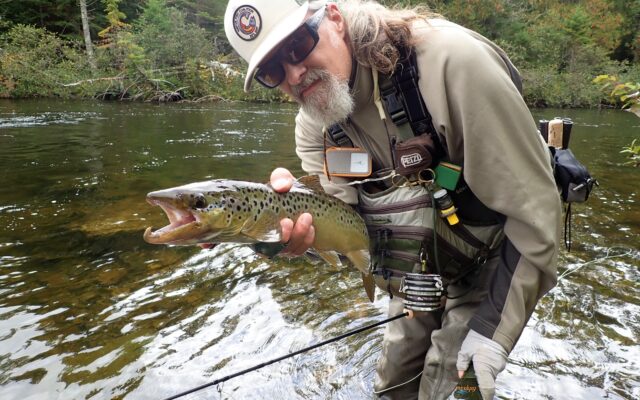
Climate change affecting Maine waters is bad for fish and anglers alike
By Bob Mallard
At the end of September, when most waters I fish in Maine closed to fishing for the season, it was apparent that what I had just seen was no fluke. In fact, it now appears to be a clear and undeniable trend.
As has been the case the last five years or so, September fishing for lake-run landlocked salmon and brook trout was underwhelming, to say the least.
I spent the last five days of the fishing season camped at Lily Bay State Park with some friends. We used it as a base camp for fishing the lower Roach River. While we caught fish, and some good ones, the fishing was nothing like it has been in the past. To put it bluntly, it was pretty disappointing.
After setting up camp, we headed to the river for a couple of hours of fishing before settling in for the night. Although when I stepped into the water on Sept. 26, it didn’t feel cold. When I dipped my hand in, it actually felt warm. A quick temperature check showed the water to be 62 degrees, notably warmer than it should have been for that time of year.

ROACH RIVER FISHING – Bangor Daily News outdoors contributor Bob Mallard shows off the fall-run landlocked salmon he caught while fly fishing on the Roach River.
There was a time, and not that long ago, when I would venture to the Roach River on Sept. 1 and immediately get into fish. By the 15th, the fishing was in full swing, and by the last week of the month it would be lights out. Ten-fish days were common, and 20-plus-fish days by no means rare.
In many cases, I’d stop fishing because I was tired of catching fish, not tired of not catching fish.
The same situation played out on the lower Dead River, only it was the end of October and there was still a month of fishing left. Again, the water was oddly warm, mid-50s, and the fall-run fish were not there in the numbers or size they should have been for that time of year. An area where the fish spawn was devoid of redds, while less than a decade ago I could count 10 or more being guarded by large trout and salmon.
Closer to home, the Kennebec River from Wyman Dam to below Abnaki Dam in Madison produced another marginal fall fishing season. It never really happened above Abnaki as the season closed before the fish got active or the fall blue-winged olive hatch took off.
Below Abnaki, I didn’t start getting into fish — beyond freshly stocked ones — until mid-November, and the BWO hatch never really happened.
For years, October was my favorite time to fish the middle Kennebec. I’d float the Solon stretch weekly, and wade Bingham equally frequently. It was about as reliable as a fishery got, with predictable hatches and active fish.
It seems as though everything has shifted out a few weeks, with both high water temperatures and poor hatches throughout the month.
To be clear, while fall fishing is pushing out, spring fishing is pulling in. Twenty years ago, when I first opened Kennebec River Outfitters, I told my customers to show up between June 5 and June 15 to take advantage of the spring mayfly hatches on the middle Kennebec River. By the time I closed the doors five years ago or so, I was telling folks to be here by Memorial Day or risk missing the hatches.
Ice-out and hatches on ponds are coming earlier as well. A decade or so ago, it was not unusual to encounter ice in remote ponds in mid and even late May. Today, many ponds are ice free prior to Mother’s Day.
The once late May black quill hatch is now happening in mid-May. And the early June ants and beetles are now showing up around Memorial Day.
Early springs and late falls are resulting in longer and deeper summers. While salmonids can survey some level of warm water for a period of time, how warm and for how long is the question.
And while species can adapt to changes in the environment, it’s a race against time and if things happen too fast, the result is often extirpation.
In addition to what is dangerously warm water for salmonids, we are also experiencing summer and fall droughts. Small streams are going intermittently, big rivers are recording record low flows, critically important spawning streams are running low, and lake levels are retreating beyond boat launches and docks. This is bad for fish.
At some point in the not-so-distant future, the Maine Department of Inland Fisheries and Wildlife is going to have to respond to the changes in Maine’s seasons and the new extremes — chronic warm and low water. This will mean looking at temporary fishing closures during high-stress periods as is being done in Montana, Idaho and Yellowstone National Park to protect our wild native fish.